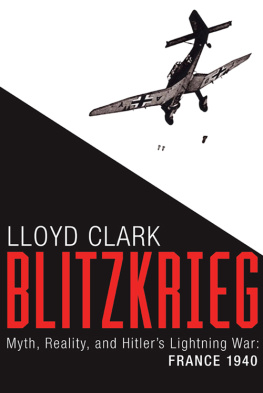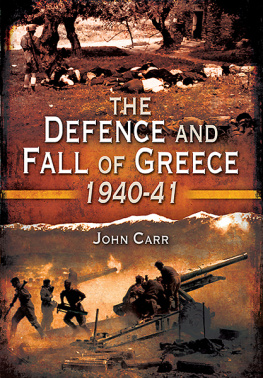R A F
ON THE
OFFENSIVE
THE REBIRTH OF TACTICAL AIR
POWER 19401941
GREG BAUGHEN
RAF ON THE OFFENSIVE
The Rebirth of Tactical Air Power 19401941
First published in Great Britain in 2018 by
Frontline Books
An imprint of
Pen & Sword Books Ltd
Yorkshire - Philadelphia
Copyright Greg Baughen
ISBN 978 1 52673 515 7
eISBN: 978 1 52673 5164
Mobi ISBN: 978 1 52673 5171
The right of Greg Baughen to be identified as Author of this work has been asserted by him in accordance with the Copyright, Designs and Patents Act 1988.
A CIP catalogue record for this book is available from the British Library
All rights reserved. No part of this book may be reproduced or transmitted in any form or by any means, electronic or mechanical including photocopying, recording or by any information storage and retrieval system, without permission from the Publisher in writing.
Pen & Sword Books Ltd incorporates the Imprints of Aviation, Atlas, Family History, Fiction, Maritime, Military, Discovery, Politics, History, Archaeology, Select, Wharncliffe Local History, Wharncliffe True Crime, Military Classics, Wharncliffe Transport, Leo Cooper, The Praetorian Press, Remember When, Seaforth Publishing and Frontline Publishing.
For a complete list of Pen & Sword titles please contact
PEN & SWORD BOOKS LTD
47 Church Street, Barnsley, South Yorkshire, S70 2AS, England
E-mail:
Website: www.pen-and-sword.co.uk
Or
PEN AND SWORD BOOKS
1950 Lawrence Rd, Havertown, PA 19083, USA
E-mail:
Website: www.penandswordbooks.com
Contents
Acknowledgements
I would like to thank the staff of the National Archives at Kew, The RAF Museum at Hendon and the Imperial War Museum in London for their help over the years. Thanks again to Tony Buttler for help with images. My thanks also to all those who have encouraged me to continue this series.
Introduction
In May 1941, the survivors of the Commonwealth forces rescued from the beaches of southern Greece prepared for one last stand on the island of Crete. On 20 May, a fleet of Ju 52 transports appeared over their heads and the sky filled with parachutes as thousands of crack German airborne troops descended onto the defenders. More followed in gliders, and once the airfields had been captured, many thousands more landed in transports. There were no RAF aircraft operating from the airfields the Commonwealth forces were trying to defend. They had no air support to help beat off the invaders and no fighter protection as the Ju 87 dive-bombers once more tormented Allied troops. It had been a similar story weeks before in Greece. For those who escaped to Egypt, it was the same old question: where was the RAF? Why was history repeating itself? Why did the British Army not have something like the Stuka dive-bomber? Once again the Royal Navy had had to pluck the survivors from the beaches. Just as had been the case twelve months before, after the fall of France, it was no longer safe for RAF personnel to venture out in their air force blue uniforms. The Royal Air Force found itself rechristened the Royal Absent Force in politer company at least. Many soldiers preferred an earthier alternative for the second letter.
The events in Crete were being followed very closely many thousands of miles away on another, much larger, island off mainland Europe. To the defence chiefs in London it was a dramatic and rather frightening demonstration of how island defences could be overwhelmed by airborne troops. Could the same happen in Britain? All the intelligence suggested that the Soviet Union was Germanys next target, but no-one expected the Red Army to be any more successful at stopping the fearsome panzers than any of their previous opponents. At best, Soviet resistance might mean a two-month postponement before Britain once more faced the might of the German Army alone. Come the late summer of 1941, Britain might once again be facing the threat of invasion. Was Britain any better prepared than twelve months before? Could airborne troops gain a foothold in Britain? Was the RAF any more ready to help the Army defend Britain?
Britain had been fortunate in 1940. Instead of launching air and ground operations simultaneously, a formula that had brought success in all previous campaigns, Hitler had chosen to try to destroy the RAF before risking an invasion. The RAF had been preparing for an air assault on the country for twenty years; it was the only battle the RAF was capable of winning, and the Luftwaffe duly suffered its first major setback. The Wehrmacht never got as far as finding out how enfeebled the British Army was and how ill-prepared the RAF was to support it. An attempt to bomb Britain into defeat by night proved equally fruitless. On its own, air power had failed to achieve much. However, in 1941, the Luftwaffe was back in harness with the German Army and the combination was once again proving irresistible as the Germans notched up rapid victories in the Western Desert and Balkans. Perhaps the next attempt to overwhelm Britain would not be preceded by an air-only campaign. The next time the Luftwaffe ventured over Britain in strength by day, it might be flying over an invasion fleet.
Chapter 1
Fighters for the Future
T hroughout the Twenties and Thirties, the Air Staff had nailed their colours to the strategic bomber mast. The year 1940 had been one of fluctuating fortunes for this policy. It had started with the Air Staff certain in their belief that the stalemate on the Western Front would continue indefinitely, just as it had in the First World War, and it would be left to the opposing bomber fleets to decide the war. As soon as the Anglo-French alliance had more bombers than Germany, they thought, then the war would move inexorably towards an Allied victory. With bomber superiority, victory on the ground would be a mere formality.
Then the German blitzkrieg seemed to change everything. Poland and Norway had been defeated rapidly, but nobody imagined the panzers, supported by the Luftwaffe, would trouble the mighty French Army. Nobody expected what followed. In a mere six weeks, France was defeated; instead of the air assault Britain had prepared for, the danger was an invasion the country had not prepared for. For a brief period, the talk was of how the RAF might support the Army in defence of British shores. Hardened bomber advocates like Air Commodore John Slessor, a future Chief of Air Staff, conceded that perhaps after all there was a place in the RAF for something like the Stuka.
But the invasion never came and instead the country found itself engaged in the air-only Battle of Britain. The war was very quickly returning to how the Air Staff had always believed wars of the future would be fought with armies and navies playing secondary roles. Victory in the Battle of Britain restored RAF pride and confidence in its importance. The German strategy in the Battle of Britain, and the Blitz that followed, seemed to be a vindication of the Air Ministrys belief that air power was the decisive factor in war. Were not the Germans turning to the very strategy the Air Staff had always advocated? All Britain had to do to guard against invasion was maintain powerful bomber and fighter forces in Britain. Germany would never dare launch an invasion fleet without air superiority, and if they did, then Bomber Command would crush it. An army was scarcely needed. It was what Hugh Trenchard the first Chief of the Air Staff, often labelled the father of the Royal Air Force had always claimed. Domination of the air made conventional land battles impossible. Churchill agreed; he had been mesmerized for years by the seemingly unlimited power of the bomber. As far as the Prime Minister was concerned, the sole purpose of the British Army was to force the enemy to concentrate its invasion force at a particular point so that the RAF and Royal Navy could destroy it. Churchill had good reason to believe the Navy could cause havoc amongst an invasion armada. There was less justification for thinking the RAF would be as effective. In the first year of war, Bomber Command had not sunk a single enemy ship of any description.










